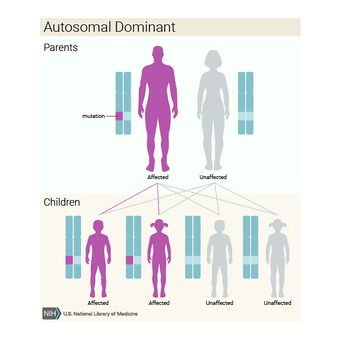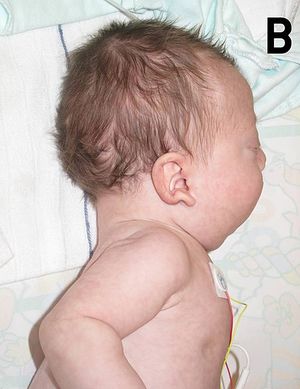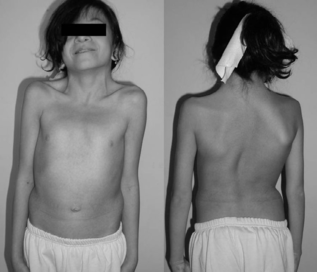Noonan Syndrome: Difference between revisions
No edit summary |
No edit summary |
||
| Line 53: | Line 53: | ||
* Rib abnormalities | * Rib abnormalities | ||
* Genu valgum ( Knock knees) | * Genu valgum ( Knock knees) | ||
[[File:12 yr old female with NS.png|alt=A female patient with chest malformations and rib abnormalities|left|thumb]] | [[File:12 yr old female with NS.png|alt=A female patient with chest malformations and rib abnormalities|left|thumb|317x317px]] | ||
Individuals with NS may also present less common problems including: | Individuals with NS may also present less common problems including: | ||
Revision as of 15:41, 20 September 2020
<div class="noeditbox">This article or area is currently under construction and may only be partially complete. Please come back soon to see the finished work! ({{REVISIONDAY}}/{{REVISIONMONTH}}/{{REVISIONYEAR}})</div>
Top Contributors - Kirenga Bamurange Liliane, Lucinda hampton, Chelsea Mclene, Naomi O'Reilly, Kim Jackson, Rucha Gadgil and Leana Louw
Definition[edit | edit source]
Noonan Syndrome (NS) is an autosomal dominant condition or a genetic mutation that prevents the normal development of different parts of the body. [1]
Noonan Syndrome is a genetic condition that affects both girls an boys in so many ways including:
- distinctive facial features such as broad or webbed neck, drooping eyelids and a wider-than-usual distance between the eyes
- heath problems such as short stature
- chest deformity,
- congenital heart disease
- pulmonary stenosis,
- physical problems
- and possible developmental delays
Noonan and Ehmke were the first to describe a succession of patients with same similarities including unusual faces and multiple malformations like congenital heart disease. As a result, these patients were previously thought to have a form of Turner syndrome, with has a lot of similarities in its clinical features with Noonan Syndrome.[1]
The eponym “Noonan syndrome” was then adopted in recognition of Dr. Jacqueline Noonan who was the first to indicate that this condition occurs in both genders; could be associated with normal chromosomes included congenital heart defects and could be familial.[2]
Epidemiology / Pathological Process[edit | edit source]
The Noonan Syndrome is caused by a mutation of a gene or a faulty gene that is usually inherited from one of the parents. The most commonly altered genes are:
- the PTPN11 gene
- the SOS1 gene
- the RIFT1 gene
- the KRAS
Even though the symptoms are usually the same for all different genes, two of them are associated to specific conditions. The faulty PTPN11 gene is commonly associated with pulmonary stenosis characterized by a narrowed heart valve and the faulty RAF1 gene, associated with cardiomyopathy which is a disease of the heart muscle.
Noonan Syndrome can be caused by mutations in multiple genes. Mutations in the altered genes occur at different degrees. The mutations in the PTPN11 gene cause about half of all cases. SOS1 gene mutations seem to be the second biggest with an additional 10 to 15 percent, followed by the genes RAF1 and RIT1 that account each for about 5 percent of cases. Mutations in other genes each account for a small number of cases. The cause of Noonan syndrome in 15 to 20 percent of people with this disorder is unknown.
The condition is present from before birth, although milder cases may not be diagnosed until a child gets older. It is believed that 1 in 1000 to 1 in 2500 children.[3]
Clinical Presentation[edit | edit source]
NS is most often characterized by facial and musculoskeletal features. Although these features are more present during early childhood, they change over the time and appear less characteristic during adulthood:
- In the newborn infant, the head is large with a small face, a tall forehead, wide-spaced eyes, short nose, low set ears, and a broad or webbed neck
Many infants with NS also have heart (cardiac) defects such as
- Pulmonary valvular stenosis
- Hypertrophic cardiomyopathy
- Septal defects
The following characteristics are also seen among individuals with NS:
- Short stature: up to 83% of people with NS have a short stature
- Pectus deformity of the chest with pectus carinatum (protrusion of sternum an rib) and pectus excavatum (hollow chest)
- Kyphosis
- Scoliosis
- Cubitus valgus (outward deviation of the elbows)
- Rounded shoulders
- Rib abnormalities
- Genu valgum ( Knock knees)
Individuals with NS may also present less common problems including:
- Leaning disability: children with NS tend to often have a mild learning disability due to a lower IQ average
- Feeding problems: children with NS may have problems with sucking and chewing
- Speech problems: articulation difficulty due to a high arched palate and weak muscles
- behavioral problems: some children with NS may have attention problems or difficulty to describe their or people emotions
- Eyes condition such as squint, lazy eye, astigmatation
- Hearing loss
- Hypotonia: decreased muscle tone will make children with NS reach early milestones later compared to other children
- Undescended testicles: one or or both testicles may fail to drop into the scrotum in boys with NS
- Infertitility can be diagnose in boys if undescended testicles are not corrected at an early age
- Lymphoedema
- Bone marrow problems
- Skin problems such as dystrophic nails; extra prominence on pads of fingers and toes; follicular keratosis; hyperelastic skin; moles; thick curly hair or thin sparse hair.[3]
Diagnostic Procedures[edit | edit source]
NS maybe suspected before birth based on the results of a fetal ultrasonography which used to create an image of the developing fetus.[4]
Outcome Measures[edit | edit source]
add links to outcome measures here (see Outcome Measures Database)
Management / Interventions[edit | edit source]
add text here relating to management approaches to the condition
Differential Diagnosis[edit | edit source]
Resources[edit | edit source]
add appropriate resources here
References[edit | edit source]
- ↑ 1.0 1.1 https://emedicine.medscape.com/article/947504-overview#a4
- ↑ https://emedicine.medscape.com/article/947504-overview
- ↑ 3.0 3.1 Bhambhani V, Muenke M. Noonan syndrome. Am Fam Physician. 2014;89(1):37-43
- ↑ https://www.ncbi.nlm.nih.gov/books/NBK1124/









